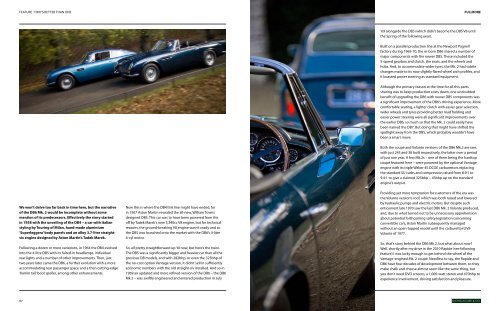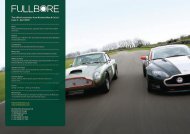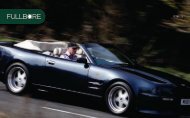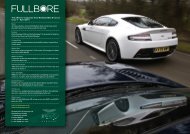Create successful ePaper yourself
Turn your PDF publications into a flip-book with our unique Google optimized e-Paper software.
FEATURE : TWO’S BETTER THAN ONE<br />
We won’t delve too far back in time here, but the narrative<br />
of the DB6 Mk. 2 would be incomplete without some<br />
mention of its predecessors. Effectively the story started<br />
in 1958 with the unveiling of the DB4 – a car with Italian<br />
styling by Touring of Milan, hand-made aluminium<br />
‘Superleggera’ body panels and an alloy 3.7-litre straightsix<br />
engine designed by Aston Martin’s Tadek Marek.<br />
Following a dozen or more variations, in 1964 the DB4 evolved<br />
into the 4-litre DB5 with its faired-in headlamps, individual<br />
rear lights and a number of other improvements. <strong>The</strong>n, just<br />
two years later came the DB6, a further evolution with a more<br />
accommodating rear passenger space and a then cutting-edge<br />
‘Kamm tail’ boot spoiler, among other enhancements.<br />
07<br />
Now this is where the DB4/5/6 line might have ended, for<br />
in 1967 Aston Martin revealed the all-new, William Towns<br />
designed DBS. This car was to have been powered from the<br />
off by Tadek Marek’s new 5,340cc V8 engine, but for technical<br />
reasons, the ground-breaking V8 engine wasn’t ready and so<br />
the DBS was launched onto the market with the DB6’s 4-litre<br />
6-cyl motor.<br />
So, all pretty straightforward up ‘til now, but here’s the twist.<br />
<strong>The</strong> DBS was a significantly bigger and heavier car than all the<br />
previous DB models, and with 282bhp, or even the 325bhp of<br />
the no-cost option Vantage version, it didn’t sell in sufficiently<br />
economic numbers with the old straight-six installed. And so in<br />
1969 an updated and more refined version of the DB6 – the DB6<br />
Mk 2 – was swiftly engineered and entered production in July<br />
FULLBORE<br />
’69 alongside the DBS (which didn’t become the DBS V8 until<br />
the Spring of the following year).<br />
Built on a parallel production line at the Newport Pagnell<br />
factory during 1969-70, the re-born DB6 shared a number of<br />
major components with the newer DBS. <strong>The</strong>se included the<br />
5-speed gearbox and clutch, the seats, and the wheels and<br />
hubs. And, to accommodate wider tyres, the Mk. 2 had subtle<br />
changes made to its now slightly flared wheel arch profiles, and<br />
it boasted power steering as standard equipment.<br />
Although the primary reason at the time for all this parts<br />
sharing was to keep production costs down, one undoubted<br />
benefit of upgrading the DB6 with newer DBS components was<br />
a significant improvement of the DB6’s driving experience. More<br />
comfortable seating, a lighter clutch with easier gear selection,<br />
wider wheels and tyres providing better road holding and<br />
easier power steering were all significant improvements over<br />
the earlier DB6, so much so that the Mk. 2 could easily have<br />
been named the DB7. But doing that might have shifted the<br />
spotlight away from the DBS, which probably wouldn’t have<br />
been a smart move.<br />
Both the coupé and Volante versions of the DB6 Mk.2 are rare,<br />
with just 245 and 38 built respectively, the latter over a period<br />
of just one year. A few Mk.2s – one of them being the hardtop<br />
coupé featured here – were powered by the optional Vantage<br />
engine with its triple Weber 45 DCOE carburettors replacing<br />
the standard SU carbs and compression raised from 8.9:1 to<br />
9.4:1 to give a claimed 325bhp – 43bhp up on the standard<br />
engine’s output.<br />
Providing yet more temptation for customers of the era was<br />
the Volante version’s roof, which was both raised and lowered<br />
by hydraulic pumps and electric motors. But despite such<br />
enticement late 1970 saw the last DB6 Mk. 2 Volante produced,<br />
and, due to what turned out to be unnecessary apprehension<br />
about potential forthcoming safety legislation concerning<br />
convertible cars, Aston Martin subsequently managed<br />
without an open-topped model until the carburettor’d V8<br />
Volante of 1977.<br />
So, that’s story behind the DB6 Mk.2, but what about now?<br />
Well, shortly after my drive in the 2010 Rapide (see following<br />
feature) I was lucky enough to get behind the wheel of the<br />
Vantage-engined Mk. 2 coupé. Needless to say, the Rapide and<br />
DB6 have four decades of development between them, so they<br />
make chalk and cheese almost seem like the same thing, but<br />
you don’t need DVD screens, a 1,000-watt stereo and 470bhp to<br />
experience involvement, driving satisfaction and pleasure.






